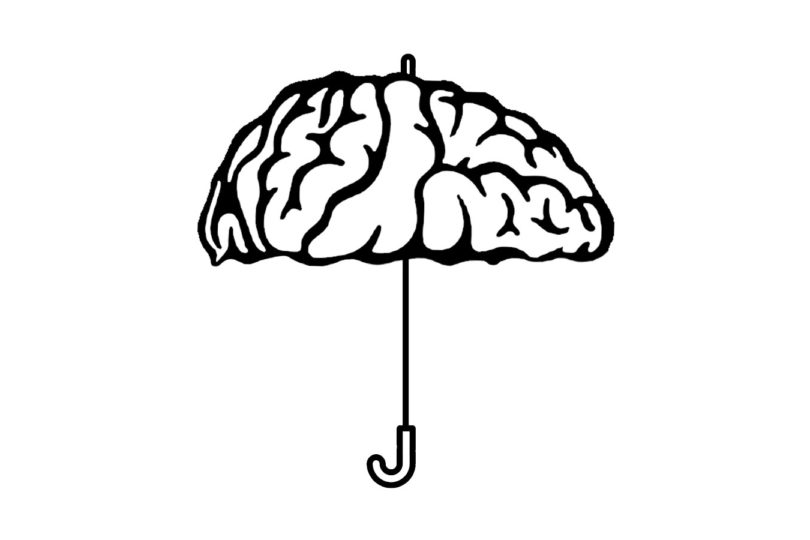Introduction
The Empathy Project was created by Heather Cole, Ben Moliterno, Wei Yuan, and Annie Zukowski for Creative Computing Studio during the fall of 2018.
The Empathy Project portrays what a manic and psychotic experience of a person with Bipolar I Disorder could be like. This artistic representation gives a taste of inner thoughts, feelings, and challenges that those with bipolar disorder may experience.
Everyone’s experience is different.
Let’s take a new perspective and empathize with each other’s challenges.
Motivation
The Empathy Project aims to help destigmatize the issues surrounding mental health. We have talked and interviewed with several people with bipolar disorder, and have combined those different experiences to create a new one. This new experience aims to expand people’s understanding and perception of bipolar disorder, and, by extension, overall mental health. The new experience, The Empathy Project, puts the user in the shoes of someone going through manic symptoms. The audience also participates in this experience by watching the user and seeing through their eyes. The goal of The Empathy Project is to invoke compassion and a new understanding of the invisible challenges other people may face.
Themes
This project incorporates elements of the themes of liveness and ambiguity. Liveness really comes into play when there is a user and an audience – when it is more of a performance. It is also relevant with the user, as the user really lives in another person’s shoes and sees through their eyes. Ambiguity is also present – there are no instructions on how the user should experience the project. They can just do what feels natural and explore the space.
Technologies
Unity
Interaction Scripts in C++
Max 7 Audio
Oculus Rift
VR Backpack
Motion Capture System
Spatial Audio System
VT ICAT Perform Studio
Background Information on Bipolar I Disorder
- In Type I Bipolar Disorder, mania occurs more often than depression
- Mania can be accompanied by psychosis
- Cycle between high and low moods over time
- High and low moods can last a few hours to months
- About 2.5% of the US population has some form of bipolar disorder (nearly 6 million people)
Mania and Psychosis
Symptoms
- Elevated mood can be presented as euphoria or irritability
- Racing thoughts and sometimes rapid speech
- Exaggerated self-confidence and grandiosity
- Increased energy, hyperactivity, decreased need for sleep
- Mania can sometimes lead to psychosis that induces visual, auditory, and sometimes even tactile hallucinations.
Challenges
- Can lead to erratic, unhealthy, impulsive, and/or risky behavior
- Pursue grandiose, unrealistic delusions
- Lose touch with reality
Depression
Symptoms
- Depressed mood, loss of pleasure
- Low energy and activity
- Feelings of guilt and worthlessness
Challenges
- Lack of motivation and energy
- Destructive thoughts
- Thoughts of suicide and/or self-harm
[Source: National Institute of Mental Health (nimh.nih.gov/health/topics/bipolar-disorder)]
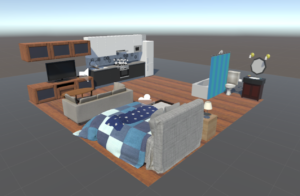
The Environment
Our Virtual Reality environment incorporates elements of realism to help immerse the user into a new perspective.
The surroundings are that of a studio apartment, which has a kitchen, living room, bedroom, and a bathroom. Many of the elements presented in the room are interactive:
- Light switch
- Dishes
- Stove
- Record player
- Pillows
- Lamp
- Alarm clock
- Soap
- Toothbrush
The environment also uses some symbolism to help convey feelings and emotions that a person with bipolar disorder may experience.
Elements in the apartment that are missing or are oddly presented are purposeful:
- Lack of windows and doors
- Someone with bipolar disorder may feel isolated, alone, or too paranoid to try to communicate with others
- Endlessly generating dishes
- Those with bipolar disorder may have challenges with cleaning and hygiene due to a possible lack of motivation and with interruptive racing thoughts.
Representation of Symptoms
Many of the symptoms are represented through the narration of internal thoughts.
Similar to real life, the narration shows the internal thought process and gradual presentation of mental symptoms.
Sleeping Habits
A person’s normal sleep cycle can be disrupted by mania and psychosis.
- With mania, the person may get less sleep due to increased energy and hyperactivity.
- With psychosis, the person may forget to sleep due to losing touch with reality as well as losing of a sense of time.
“Oh yay… another night with only 5 hours of sleep.”
Lack of Focus, Forgetfulness
Mania may cause difficulties focusing, and depression may bring about fatigue and forgetfulness.
“Where’s my toothbrush?”
Grandiose Delusions
Mania may cause a person to have grandiose thoughts or delusions.
“Ah so… God told me to hide my toothbrush…”
Hallucinations
Psychosis can lead to a person losing touch with reality.
“What was that?!”
Deep Nonsensical Thought
Mania can lead to a person having thoughts that seem very deep and obscure.
“What is this place…”
Presentation
The live demonstration with the one user and the audience is purposeful and meaningful.
The User
The ICAT Perform Studio has motion capture and spatial audio systems. With these technologies available, the user dons a VR backpack that has an Oculus Rift with tracking sensors attached.
The user can freely move about the room and interact with the to-scale apartment in real space.
The user also experiences spatial audio as they move about the apartment. The different, relevant narrations are triggered to begin as the user traverses around the apartment.
The Audience
As the audience (those without bipolar disorder), we cannot experience the world through the user’s (a person with bipolar disorder) perspective, but we can learn to understand and empathize with their experience.
The audience can observe the user moving throughout the room and wonder what they are doing and their motivations behind their actions, similar to the real world roles as neurotypical people and those with bipolar disorder.
We, as the audience, can also see through the user’s perspective by watching the monitor on the wall, which displays what the user is seeing in virtual reality.
The audience is also able to experience the sounds and narrations that the user experiences. The narrations are spatially located to where the user is, so the experience of the audience is that the narration is coming from the user.
This presentation can give the audience an insight into another person’s perspective and life.
Demonstration
This demo shows the interactive elements of The Empathy Project.
This video shows the performance aspect of The Empathy Project.
Creative Note
During the final performance of The Empathy Project on December 11, 2018, brochures with this information was handed out. The brochure:
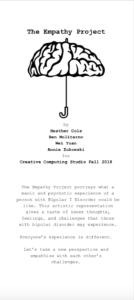 Front of Brochure
Front of Brochure
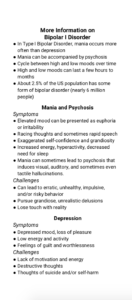 Inside Flap of Brochure
Inside Flap of Brochure
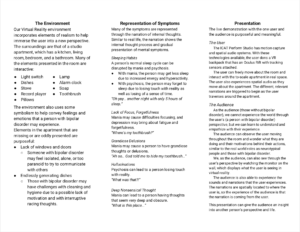 Inside of Brochure
Inside of Brochure
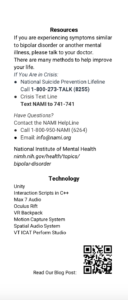 Back of Brochure
Back of Brochure
You can view a high quality version here.
Resources
If you are experiencing symptoms similar to bipolar disorder or another mental illness, please talk to your doctor.
There are many methods to help improve your life.
If You Are in Crisis:
- National Suicide Prevention Lifeline: Call 1-800-273-TALK (8255)
- Crisis Text Line: Text NAMI to 741-741
Have Questions?
Contact the NAMI HelpLine
- Call 1-800-950-NAMI (6264)
- Email: info@nami.org
National Institute of Mental Health: nimh.nih.gov/health/topics/bipolar-disorder
